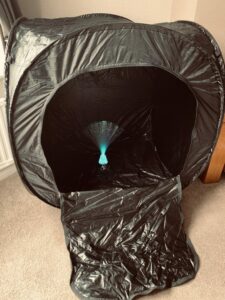One of our core pieces of equipment for Sensory Integration and Sensory Attachment Intervention is a tent. It is part of the Juniper Tree Therapy Pack that we’ve recently developed, and is a core piece of equipment found in any Occupational Therapists kit!
There are two tents that we particularly like; the Cosy Cave (sold by Special Needs Toys – click here to see, and the Sensory Pop Up Den (sold by Sensory Direct – click here to see!). We’ll talk about these a little bit, but there are tons of places you can source one from.
Tents are brilliant spaces to help to provide a sense of containment – they can be helpful for children with lots of different needs. They can be used for children to engage with adults, to have some relaxing time, to enhance sensory experiences, or to reduce environmental stimulation. We want to give you some hints and tips to think about when using a tent at home.
1. Positioning
Think about where you put a tent in the room. Children who might be nervous, fearful or anxious might want to be able to see the doorway of the room they are in so they can see quickly if someone is approaching. The Cosy Cave has two exits, which some children might find reassuring as they can withdraw quickly if they want to. The Pop Up Den has one viewing window, and a door at the other side. Experiment with what works best for your child and don’t be discouraged if you try something once and you don’t feel that it works as well as you hoped!
2. Fun Opportunities with Adults
For children who might find separating from adults difficult, tents are a lovely way to create playful opportunities for one of you to be inside and the other outside. You could play hide and seek, you could enjoy imaginary play, or you could use it as park of an obstacle course game!
Some children might really seek opportunities to be close to you, and a tent can enhance this. You can read books together in there, or create a relaxing space whilst ‘dampening down’ the interruptions from the rest of the world! Remember to be guided by what your child seeks.

3. Furnishing the Space!
Tents are a great space to create cosy and safe nurturing spaces. Soft cushions, beanbags, blankets are all useful things to consider using – heavier objects can help to provide deep pressure (for example big cushions). Putting lots of soft furnishings inside also means that you can push against these and receive ‘resistance’ feedback (or ‘proprioception’), which is calming and organising.
4. Adjust the Space
The Cosy Cave might be useful for children who wouldn’t tend to go into enclosed spaces, as removing the roof can make it seem much less scary and overwhelming. Think about different ways you can adjust the space depending on what they like – lots of light or no light? Lots of things inside or keeping it clear and unobstructed? Think aloud with your child as to how they might like it setting up, and experiment with different ideas.

5. Consistency and Novelty
One of the central tenets of Sensory Attachment Intervention is creating repeated opportunities throughout the day to connect with, and regulate with your child. Ideally, you want a tent to be available all of the time (perhaps in the same place) so your child can learn to access it in a way that is helpful for them. Alternatively, if you’re spending time in a particular room of the house you might be able to bring the tent along with you so your child can be nearby, if they wish! You can create novelty by changing what’s inside – depending on what the child wants to use the space for.
If you have limited space, most pop up tents can be collapsed and stored in a handy bag. Do not be fooled however, if you see an Occupational Therapist who manages to quickly and smoothly fold up a tent – be assured it will have taken years of practice (we’ve still not got the skill yet!).
Tents are a truly brilliant play tool for children. Keep in mind, they should be guided by the child and never ‘instructed’ or ‘prescribed’ – they are a way of enhancing play and connection with those around a child, and also providing some safe distance space if the child wants. Please do let us know if you have any more questions!
